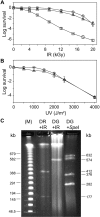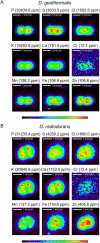Deinococcus geothermalis: the pool of extreme radiation resistance genes shrinks
- PMID: 17895995
- PMCID: PMC1978522
- DOI: 10.1371/journal.pone.0000955
Deinococcus geothermalis: the pool of extreme radiation resistance genes shrinks
Abstract
Bacteria of the genus Deinococcus are extremely resistant to ionizing radiation (IR), ultraviolet light (UV) and desiccation. The mesophile Deinococcus radiodurans was the first member of this group whose genome was completely sequenced. Analysis of the genome sequence of D. radiodurans, however, failed to identify unique DNA repair systems. To further delineate the genes underlying the resistance phenotypes, we report the whole-genome sequence of a second Deinococcus species, the thermophile Deinococcus geothermalis, which at its optimal growth temperature is as resistant to IR, UV and desiccation as D. radiodurans, and a comparative analysis of the two Deinococcus genomes. Many D. radiodurans genes previously implicated in resistance, but for which no sensitive phenotype was observed upon disruption, are absent in D. geothermalis. In contrast, most D. radiodurans genes whose mutants displayed a radiation-sensitive phenotype in D. radiodurans are conserved in D. geothermalis. Supporting the existence of a Deinococcus radiation response regulon, a common palindromic DNA motif was identified in a conserved set of genes associated with resistance, and a dedicated transcriptional regulator was predicted. We present the case that these two species evolved essentially the same diverse set of gene families, and that the extreme stress-resistance phenotypes of the Deinococcus lineage emerged progressively by amassing cell-cleaning systems from different sources, but not by acquisition of novel DNA repair systems. Our reconstruction of the genomic evolution of the Deinococcus-Thermus phylum indicates that the corresponding set of enzymes proliferated mainly in the common ancestor of Deinococcus. Results of the comparative analysis weaken the arguments for a role of higher-order chromosome alignment structures in resistance; more clearly define and substantially revise downward the number of uncharacterized genes that might participate in DNA repair and contribute to resistance; and strengthen the case for a role in survival of systems involved in manganese and iron homeostasis.
Conflict of interest statement
Figures







Similar articles
-
Comparative genomics of Thermus thermophilus and Deinococcus radiodurans: divergent routes of adaptation to thermophily and radiation resistance.BMC Evol Biol. 2005 Oct 20;5:57. doi: 10.1186/1471-2148-5-57. BMC Evol Biol. 2005. PMID: 16242020 Free PMC article.
-
Genome of the extremely radiation-resistant bacterium Deinococcus radiodurans viewed from the perspective of comparative genomics.Microbiol Mol Biol Rev. 2001 Mar;65(1):44-79. doi: 10.1128/MMBR.65.1.44-79.2001. Microbiol Mol Biol Rev. 2001. PMID: 11238985 Free PMC article. Review.
-
The Site-Directed A184S Mutation in the HTH Domain of the Global Regulator IrrE Enhances Deinococcus radiodurans R1 Tolerance to UV Radiation and MMC Shock.J Microbiol Biotechnol. 2015 Dec 28;25(12):2125-34. doi: 10.4014/jmb.1507.07008. J Microbiol Biotechnol. 2015. PMID: 26370803
-
A Genome-Wide Search for Ionizing-Radiation-Responsive Elements in Deinococcus radiodurans Reveals a Regulatory Role for the DNA Gyrase Subunit A Gene's 5' Untranslated Region in the Radiation and Desiccation Response.Appl Environ Microbiol. 2017 May 31;83(12):e00039-17. doi: 10.1128/AEM.00039-17. Print 2017 Jun 15. Appl Environ Microbiol. 2017. PMID: 28411225 Free PMC article.
-
Conservation and diversity of radiation and oxidative stress resistance mechanisms in Deinococcus species.FEMS Microbiol Rev. 2019 Jan 1;43(1):19-52. doi: 10.1093/femsre/fuy037. FEMS Microbiol Rev. 2019. PMID: 30339218 Free PMC article. Review.
Cited by
-
Quantitative Characterization of the Growth of Deinococcus geothermalis DSM-11302: Effect of Inoculum Size, Growth Medium and Culture Conditions.Microorganisms. 2015 Aug 20;3(3):441-63. doi: 10.3390/microorganisms3030441. Microorganisms. 2015. PMID: 27682099 Free PMC article.
-
Structural and functional characterization of DdrC, a novel DNA damage-induced nucleoid associated protein involved in DNA compaction.Nucleic Acids Res. 2022 Jul 22;50(13):7680-7696. doi: 10.1093/nar/gkac563. Nucleic Acids Res. 2022. PMID: 35801857 Free PMC article.
-
Unraveling adaptation of Pontibacter korlensis to radiation and infertility in desert through complete genome and comparative transcriptomic analysis.Sci Rep. 2015 Jun 9;5:10929. doi: 10.1038/srep10929. Sci Rep. 2015. PMID: 26057562 Free PMC article.
-
Complete genome sequence of Deinococcus rubellus Ant6 isolated from the fish muscle in the Antarctic Ocean.Front Bioeng Biotechnol. 2023 Oct 16;11:1257705. doi: 10.3389/fbioe.2023.1257705. eCollection 2023. Front Bioeng Biotechnol. 2023. PMID: 37908375 Free PMC article. No abstract available.
-
Community Ecology of Deinococcus in Irradiated Soil.Microb Ecol. 2019 Nov;78(4):855-872. doi: 10.1007/s00248-019-01343-5. Epub 2019 Apr 12. Microb Ecol. 2019. PMID: 30980101
References
-
- Lai WA, Kampfer P, Arun AB, Shen FT, Huber B, et al. Deinococcus ficus sp. nov., isolated from the rhizosphere of Ficus religiosa L. Int J Syst Evol Microbiol. 2006;56:787–791. - PubMed
-
- Gutman PD, Fuchs P, Minton KW. Restoration of the DNA damage resistance of Deinococcus radiodurans DNA polymerase mutants by Escherichia coli DNA polymerase I and Klenow fragment. Mutat Res. 1994;314:87–97. - PubMed
-
- Daly MJ, Gaidamakova EK, Matrosova VY, Vasilenko A, Zhai M, et al. Accumulation of Mn(II) in Deinococcus radiodurans facilitates gamma-radiation resistance. Science. 2004;306:1025–1028. - PubMed
Publication types
MeSH terms
Substances
Grants and funding
LinkOut - more resources
Full Text Sources
Other Literature Sources
Molecular Biology Databases

